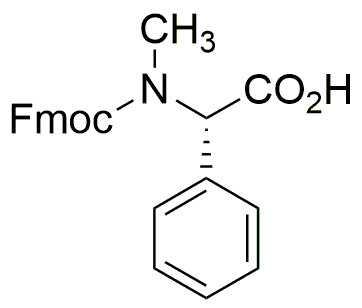Fmoc-N-methyl-L-phenylglycine is widely utilized in research focused on
- Peptide Synthesis: This compound serves as a key building block in the synthesis of peptides, particularly in solid-phase peptide synthesis, allowing for the creation of complex peptide sequences with high purity.
- Drug Development: Its unique structure makes it valuable in the pharmaceutical industry for developing novel drugs, especially those targeting specific receptors or enzymes, enhancing therapeutic efficacy.
- Bioconjugation: The chemical is used in bioconjugation processes, where it helps attach biomolecules to surfaces or other molecules, improving the functionality of diagnostic tools and drug delivery systems.
- Research in Neuroscience: Researchers utilize this compound to study neurotransmitter systems, as it can mimic natural amino acids, aiding in the understanding of neurological pathways and drug interactions.
- Material Science: It finds applications in the development of smart materials, where its properties can be tailored for specific responses to environmental stimuli, such as temperature or pH changes.
General Information
Properties
Safety and Regulations
Applications
Fmoc-N-methyl-L-phenylglycine is widely utilized in research focused on
- Peptide Synthesis: This compound serves as a key building block in the synthesis of peptides, particularly in solid-phase peptide synthesis, allowing for the creation of complex peptide sequences with high purity.
- Drug Development: Its unique structure makes it valuable in the pharmaceutical industry for developing novel drugs, especially those targeting specific receptors or enzymes, enhancing therapeutic efficacy.
- Bioconjugation: The chemical is used in bioconjugation processes, where it helps attach biomolecules to surfaces or other molecules, improving the functionality of diagnostic tools and drug delivery systems.
- Research in Neuroscience: Researchers utilize this compound to study neurotransmitter systems, as it can mimic natural amino acids, aiding in the understanding of neurological pathways and drug interactions.
- Material Science: It finds applications in the development of smart materials, where its properties can be tailored for specific responses to environmental stimuli, such as temperature or pH changes.
Documents
Safety Data Sheets (SDS)
The SDS provides comprehensive safety information on handling, storage, and disposal of the product.
Product Specification (PS)
The PS provides a comprehensive breakdown of the product’s properties, including chemical composition, physical state, purity, and storage requirements. It also details acceptable quality ranges and the product's intended applications.
Certificates of Analysis (COA)
Search for Certificates of Analysis (COA) by entering the products Lot Number. Lot and Batch Numbers can be found on a product’s label following the words ‘Lot’ or ‘Batch’.
Número de catálogo
Número de lote/lote
Certificates Of Origin (COO)
This COO confirms the country where the product was manufactured, and also details the materials and components used in it and whether it is derived from natural, synthetic, or other specific sources. This certificate may be required for customs, trade, and regulatory compliance.
Número de catálogo
Número de lote/lote
Safety Data Sheets (SDS)
The SDS provides comprehensive safety information on handling, storage, and disposal of the product.
DownloadProduct Specification (PS)
The PS provides a comprehensive breakdown of the product’s properties, including chemical composition, physical state, purity, and storage requirements. It also details acceptable quality ranges and the product's intended applications.
DownloadCertificates of Analysis (COA)
Search for Certificates of Analysis (COA) by entering the products Lot Number. Lot and Batch Numbers can be found on a product’s label following the words ‘Lot’ or ‘Batch’.
Número de catálogo
Número de lote/lote
Certificates Of Origin (COO)
This COO confirms the country where the product was manufactured, and also details the materials and components used in it and whether it is derived from natural, synthetic, or other specific sources. This certificate may be required for customs, trade, and regulatory compliance.


